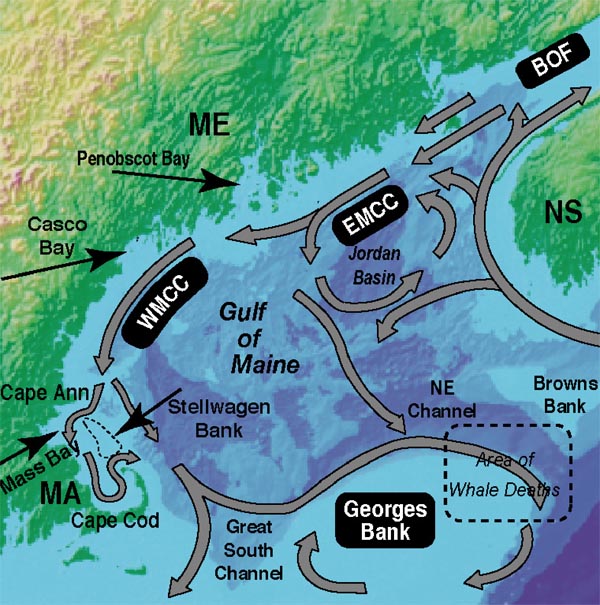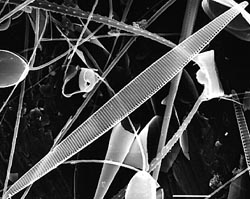Pseudo-nitzschia: Emerging HAB threat in the Gulf of Maine
PIs: D.M. Anderson (WHOI), D.L. Erdner (Univ. of Texas), S.S. Bates (Fisheries and Oceans Canada)
In July, 2003, more than 20 whales, mostly humpbacks, were found dead near Georges Bank. Concurrently, several dead whales were found in nearshore waters of Maine, where 42 unexplained seal mortalities were also reported. Following negative findings for pathogens, attention shifted to algal biotoxins. Domoic acid (DA) was detected in most of the whales that were sampled, with several containing high concentrations. Plankton samples revealed multiple Pseudo-nitzschiaspecies, some known to produce DA. The scientific team concluded that the whales probably died from DA poisoning. As that biotoxin investigation evolved, our lack of knowledge of Pseudo-nitzschia and the lack of research tools for studying this genus and DA in the Gulf of Maine (GOM) became painfully apparent. We knew that multiple Pseudo-nitzschia species occur in the GOM, and that some species are toxic, but we knew nothing of their temporal or spatial distribution or the hydrographic features they are associated with, nor did we have molecular probes and detection and enumeration assays akin to those used by workers studying west coast DA events. Such tools are necessary for field investigations of Pseudo-nitzschia because morphologically similar species can co-occur, with only some being capable of DA production. The west coast probes are not directly applicable within the GOM without testing and probable modification, however, since genetic differences are often sufficient between regions to preclude a direct transfer of this kind of technology.
It is clear from the whale deaths and from subsequent examination of toxicity records that DA represents a cryptic or emerging HAB threat in the northeastern U.S. This problem has the potential for serious human health and ecosystem impacts but has not been adequately characterized in the GOM. Little is known about the toxicity and phylogeny of the causative Pseudo-nitzschia species in the region, and none of the GOM coastal states (Maine, New Hampshire, and Massachusetts) routinely monitors for DA in shellfish. Here we propose a field and laboratory study to characterize the species composition, distribution, abundance and toxicity of Pseudo-nitzschia spp. in the GOM. This is the first study of its type in the region, and thus is intended to develop the tools, local expertise and background understanding to respond to outbreaks and provide an assessment of the risk from this group of toxic organisms. We will establish and characterize Pseudo-nitzschia isolates from the GOM, including:
- Sampling nearshore and offshore waters of the GOM for Pseudo-nitzschia spp.
- Establishing clonal cultures
- Identifying the species
- Determining their toxicity
We will also develop and refine probe sequences and protocols for the molecular quantification of toxic Pseudo-nitzschia species from the GOM, including
- Comparing rRNA gene sequences to existing Pseudo-nitzschia rRNA probes
- Refining probes to target local species
- Developing whole-cell and sandwich hybridization assays for toxigenic species
- Validating both methods with laboratory and field samples
We will examine the distribution and ecology of Pseudo-nitzschia in the GOM using a) coastal samples collected from phytoplankton monitoring efforts in Maine and Massachusetts; and b) coastal and offshore samples collected during two GOM-wide survey cruises funded through a separate project. Also in this final year we will communicate project findings and transfer technologies to officials responsible for regional shellfish monitoring programs and assess the need for ASP toxin monitoring in coastal shellfish. This information will be of direct interest to the shellfish harvesting industry, to coastal managers responsible for public health and seafood safety, as well as those responsible for ecosystem management, including marine mammal strandings and mortality events.
Relevant Publications
Bates, S.S. (2000). Domoic-acid-producing diatoms: another genus added! Journal of Phycology 36, 978-983.
Bates, S.S., C.J. Bird, A.S.W. de Frietas, R. Foxall, M. Gilgan, L.A. Hanic, G.R. Johnson, A.W. McCulloch, P. Odense, R. Pocklington, M.A. Quilliam, P.G. Sim, J.C. Smith, D.V. Subba Rao, E.C.D. Todd, J.A. Walter and J.L.C. Wright (1989). Pennate diatom Nitzschia pungens as the primary source of domoic acid, a toxin in shellfish from eastern Prince Edward Island, Canada. Canadian Journal of Fisheries and Aquatic Science 46, 1203-1215.
Bates, S.S., D.L. Garrison and R.A. Horner (1998). Bloom dynamics and physiology of domoic-acid-producing Pseudo-nitzschia species in Anderson, D.M., A.D. Cembella and G.M. Hallegraeff (Eds), Physiological ecology of harmful algal blooms, Springer-Verlag, pp. 267-292.
Hasle, G.R. and E.E. Syvertsen (1996). Marine diatoms in Tomas, C.R. (Ed), Identifying Marine Diatoms and Dinoflagellates, Academic Press, pp. 5-385.
Martin, J.L., K. Haya, L.E. Burridge and D.J. Wildish (1990). Nitzschia pseudodelicatissima - a source of domoic acid in the Bay of Fundy, eastern Canada. Marine Ecology Progress Series 67, 177-182.
Scholin, C.A., P. Miller, K. Buck, F. Chavez, P. Harris, P. Haydock, J. Howard and G. Cangelosi (1997). Detection and quantification of Pseudo-nitzschia australis in cultured and natural populations using LSU rRNA-targeted probes. Limnology and Oceanography 42, 1265-1272.

